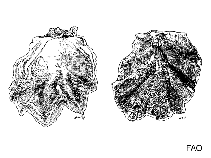Ostrea chilensis Philippi, 1854
Chilean flat oyster| Native range | All suitable habitat | Point map | Year 2050 |

|
| This map was computer-generated and has not yet been reviewed. |
| Ostrea chilensis AquaMaps Data sources: GBIF OBIS |
Upload your photos
Google image | No image available for this species;
drawing shows typical species in Ostreidae.
Google image | No image available for this species;
drawing shows typical species in Ostreidae.
Classification / Names Common names | Synonyms | CoL | ITIS | WoRMS
Bivalvia | Ostreida | Ostreidae
Environment: milieu / climate zone / depth range / distribution range Ecology
Benthic; depth range 0 - 550 m (Ref. 106914). Subtropical, preferred 24°C (Ref. 107945); 34°S - 47°S, 166°E - 72°W (Ref. 111844)
Distribution Countries | FAO areas | Ecosystems | Occurrences | Introductions
South Pacific Ocean: New Zealand and Chile. Introduced in the Atlantic: Wales, UK and France. Subtropical to temperate.
Length at first maturity / Size / Weight / Age
Maturity: Lm ?, range 5 - ? cm Max length : 10.0 cm ShL male/unsexed; (Ref. )
Minimum depth range from Ref. 356. Found in nearshore waters and in shallow subtidal zone (Ref. 106914). This is an epifaunal species found on soft sandy and muddy bottoms, as well as hard substrates. It is a brooding species where females retain the larvae until they are completely developed (Ref. 87801).
Life cycle and mating behavior Maturity | Reproduction | Spawning | Eggs | Fecundity | Larvae
Life cycle: Embryos develop into free-swimming trocophore larvae, succeeded by the bivalve veliger, resembling a miniature clam.
Main reference
References | Coordinator | Collaborators
Häussermann, V. and G. Försterra. 2009. (Ref. 87801)
IUCN Red List Status (Ref. 130435)
CITES status (Ref. 108899)
Not Evaluated
CMS (Ref. 116361)
Not Evaluated
Threat to humans
Human uses
Fisheries: commercial
FAO - Aquaculture: production; Fisheries: landings | FishSource | Sea Around Us
Tools
More information
Age/Size
Growth
Length-weight
Length-length
Morphology
Larvae
Abundance
Growth
Length-weight
Length-length
Morphology
Larvae
Abundance
Internet sources
BHL | BOLD Systems | CISTI | DiscoverLife | FAO(Fisheries: ; publication : search) | Fishipedia | GenBank (genome, nucleotide) | GloBI | Gomexsi | Google Books | Google Scholar | Google | PubMed | Tree of Life | Wikipedia (Go, Search) | Zoological Record
Estimates based on models
Nutrients: Calcium = 149 [71, 228] mg/100g; Iron = 8.53 [1.95, 15.11] mg/100g; Protein = 9.88 [8.64, 11.12] %; Omega3 = 0.313 [0.202, 0.423] g/100g; Selenium = 61 [50, 72] μg/100g; VitaminA = 0 μg/100g; Zinc = 2.04 [0.56, 3.51] mg/100g (wet weight).



